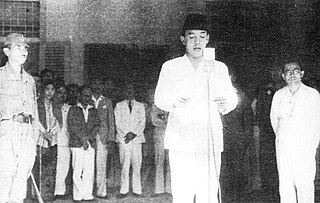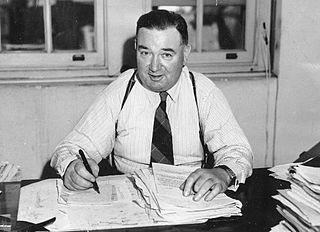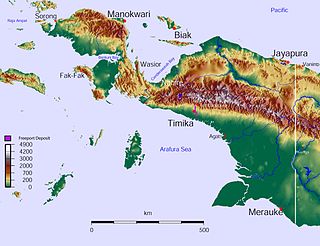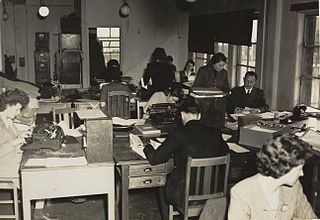
The Indonesian National Revolution, also known as the Indonesian War of Independence, was an armed conflict and diplomatic struggle between the Republic of Indonesia and the Dutch Empire and an internal social revolution during postwar and postcolonial Indonesia. It took place between Indonesia's declaration of independence in 1945 and the Netherlands' transfer of sovereignty over the Dutch East Indies to the Republic of the United States of Indonesia at the end of 1949.

The 1951 New Zealand waterfront dispute was the largest and most widespread industrial dispute in New Zealand history. Over the period, up to 20,000 workers went on strike in support of waterfront workers protesting against financial hardships and poor working conditions. Thousands more refused to handle "scab" goods. The dispute was sometimes referred to as the waterfront lockout or waterfront strike. It lasted 151 days, from 13 February to 15 July 1951. During the lockout, the Watersiders' Union was deregistered and its funds and records were seized, and 26 local watersiders' unions were set up in its place.

The Maritime Union of Australia (MUA) was a union which covered waterside workers, seafarers, port workers, professional divers, and office workers associated with Australian ports. The MUA was formed in 1993 with merger of the Seamen's Union of Australia and the Waterside Workers' Federation of Australia.
The Seamen's Union of Australia (SUA) was the principal trade union for merchant seamen in Australia from 1876 to 1991. The SUA developed a reputation as one of the most militant trade unions in Australia and was closely associated with the communist movement in Australia. The SUA merged in 1993 with the Waterside Workers' Federation to become the Maritime Union of Australia (MUA).
Tanah Merah is a town in the South Papua province of Indonesia on the bank of Digul River, located some two hundred miles from Merauke within the interior of Western New Guinea. It is the administrative center of Boven Digoel Regency.

Koninklijke Paketvaart-Maatschappij, was a Dutch shipping line in the Dutch East Indies, now Indonesia. It traded form 1888 to 1966. It was the dominant inter-island shipping line in the Dutch East Indies in the last half-century of the colonial era.
Indonesia Calling is a 1946 Australian short documentary film directed by Joris Ivens and produced by the Waterside Workers' Federation. The film depicts post-World War II Sydney as trade union seamen and waterside workers refuse to service Dutch ships containing arms and ammunition destined for Indonesia to suppress the country's independence movement. Ivens filming of the events taking place gradually became a symbol even for those who had not seen the film and had a growing following in the Netherlands, long before the film had an audience.

SS Tasman was a 4,922 gross register tons (GRT) Dutch steamship built by Earle's Shipbuilding and Engineering Company Limited, Hull in 1921 for Koninklijke Paketvaart-Maatschappij (KPM), Batavia. With outbreak of the World War II in the Pacific and the fall of the Dutch East Indies, Tasman was one of 21 KPM vessels that sought refuge in Australia. These ships became the core of the initial Southwest Pacific Area (SWPA) command's permanent local fleet under U.S. Army control. After general service as a transport, the ship was converted to a hospital ship at Melbourne. The ship, under the Dutch flag and Dutch certification under the Hague Convention, served the remainder of the war as a Dutch hospital ship.
Firemen and Deckhands' Union of New South Wales (FDU) was an Australian trade union existing between 1901 and 1993. The union covered deckhands employed on ferries, tugs, launches, lighters and hoppers, as well as enginemen, wharf hands, turnstill hands, change hands, firemen, motorboat coxmen and assistants. The FDU operated a closed shop, with all labour in the industry provided to employers through the union.

James "Big Jim" Healy was an Australian trade unionist and communist activist. Healy served as General Secretary of the Waterside Workers' Federation of Australia from 1937 to his death in 1961, a period when the union recovered from its defeat in the 1928 waterfront strike to become one of the most powerful trade unions in Australia. Healy was one of the most prominent public representatives of the communist movement in Australia during the Cold War.

SS Barossa was a steam bulk carrier. She was built in Scotland in 1938 for the Adelaide Steamship Company of South Australia. In 1942 she was burnt out in the Japanese bombing of Darwin, but she was raised and repaired. In 1949 she was the focus of a watersiders' strike in Brisbane, which as a result is sometimes called the "Barossa strike".

Bilateral relations exist between Australia and the Netherlands. Australia has an embassy in The Hague. The Netherlands has an embassy in Canberra. The two countries communicate and cooperate on a range of issues, including counterterrorism, climate change, human rights, and the Millennium Development Goals. In 2001 the countries signed an agreement on social security for those who have lived or worked in both countries.

Indonesia–New Zealand relations are foreign bilateral relations between Indonesia and New Zealand. Having common interests as democracies and neighbours in the Asia Pacific region, New Zealand and Indonesia are viewed as natural partners. Both countries are members of APEC. Indonesia and New Zealand officially established diplomatic relations in 28 June 1958. New Zealand has an embassy in Jakarta, and Indonesia has an embassy in Wellington.

The West New Guinea dispute (1950–1962), also known as the West Irian dispute, was a diplomatic and political conflict between the Netherlands and Indonesia over the territory of Dutch New Guinea. While the Netherlands had ceded sovereignty over most of the Dutch East Indies to Indonesia on 27 December 1949 following an independence struggle, it retained control over its colony on the western half of New Guinea. The Indonesian government claimed this territory as well, on the basis that it had belonged to the Dutch East Indies and that the new Republic of Indonesia was the legitimate successor to the former Dutch colony.

The Waterside Workers' Federation of Australia (WWF) was an Australian trade union that existed from 1902 to 1993. After a period of negotiations between other Australian maritime unions, it was federated in 1902 and first federally registered in 1907; its first general president was Billy Hughes.

The Netherlands Indies Government Information Service (NIGIS) was a civil secret service and propaganda organisation based in Australia, during and after World War II. NIGIS was affiliated with the Netherlands East Indies Forces Intelligence Service (NEFIS) and the Netherlands Indies Civil Administration (NICA).
Rupert Ernest Lockwood was an Australian journalist and communist activist.
The Dalfram dispute of 1938 was a political industrial dispute at Port Kembla, New South Wales, Australia protesting the export of pig iron from Australia to Japan during the Second Sino-Japanese War. It became famous for providing the nickname of Pig Iron Bob to Attorney General Robert Menzies, later Prime Minister.
Camp Victory, also known as Camp Casino, was a Royal Netherlands East Indies Army (KNIL) base and prisoner of war camp, used during World War II, near Casino, New South Wales, Australia. The Dutch government-in-exile was given extraterritorial rights over the management and conduct of the base. It was named Camp Victory by the Dutch government in the hopes of a swift recapture of the Dutch East Indies. The camp consisted mostly of tents, with only a few buildings for administrative, ablutions and recreational purposes.

MS Van Heutsz was a Dutch diesel-powered passenger and cargo vessel of the Koninklijke Paketvaart-Maatschappij (KPM) line operating from Batavia in the Dutch East Indies. The ship, as was sister ship Cremer, was designed for the longer routes of the East Indies inter-island trade extending to Singapore and Hong Kong. The ships had limited cabin accommodation for passengers but large deck passenger capacity. Much of the passenger trade was with Chinese moving between China, Singapore and the East Indies.













